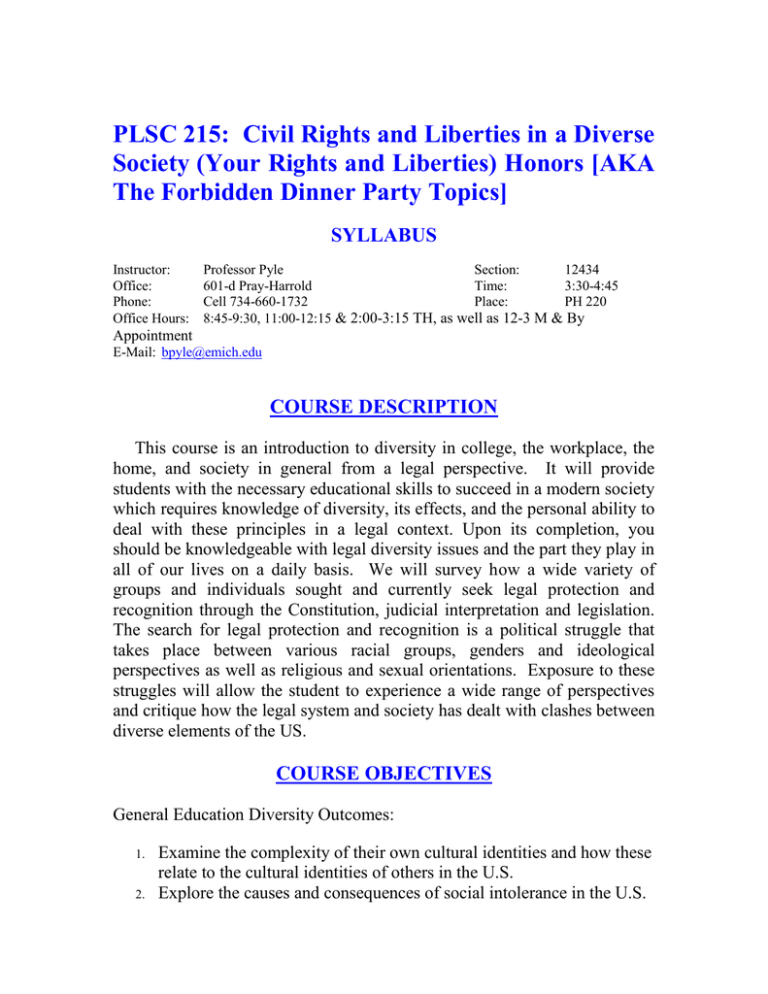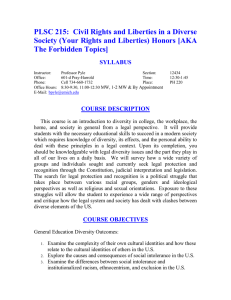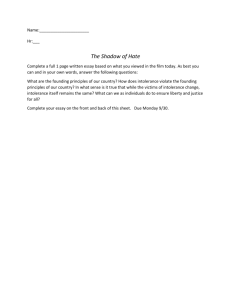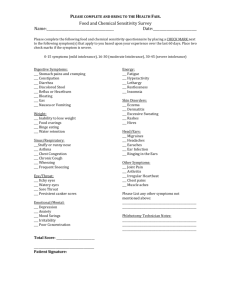PLSC 215: Civil Rights and Liberties in a Diverse
advertisement

PLSC 215: Civil Rights and Liberties in a Diverse Society (Your Rights and Liberties) Honors [AKA The Forbidden Dinner Party Topics] SYLLABUS Instructor: Office: Phone: Office Hours: Professor Pyle Section: 12434 601-d Pray-Harrold Time: 3:30-4:45 Cell 734-660-1732 Place: PH 220 8:45-9:30, 11:00-12:15 & 2:00-3:15 TH, as well as 12-3 M & By Appointment E-Mail: bpyle@emich.edu COURSE DESCRIPTION This course is an introduction to diversity in college, the workplace, the home, and society in general from a legal perspective. It will provide students with the necessary educational skills to succeed in a modern society which requires knowledge of diversity, its effects, and the personal ability to deal with these principles in a legal context. Upon its completion, you should be knowledgeable with legal diversity issues and the part they play in all of our lives on a daily basis. We will survey how a wide variety of groups and individuals sought and currently seek legal protection and recognition through the Constitution, judicial interpretation and legislation. The search for legal protection and recognition is a political struggle that takes place between various racial groups, genders and ideological perspectives as well as religious and sexual orientations. Exposure to these struggles will allow the student to experience a wide range of perspectives and critique how the legal system and society has dealt with clashes between diverse elements of the US. COURSE OBJECTIVES General Education Diversity Outcomes: 1. 2. Examine the complexity of their own cultural identities and how these relate to the cultural identities of others in the U.S. Explore the causes and consequences of social intolerance in the U.S. 3. 4. 5. Examine the differences between social intolerance and institutionalized racism, ethnocentrism, and exclusion in the U.S. Explore how diversity has affected and continues to affect income distribution, economic mobility, political access, and the democratic process in the U.S. Develop an awareness of alternative values, views, and communication styles in the U.S. Outcomes as Applied to this class: 1. To examine and increase awareness of the dimensions and complexity of diversity in American laws, institutions and cultures and the longterm effects is has upon each. Inclusive in this objective will be a discourse on students’ own diversity and how it relates to other cultural identities from a legal perspective. This course will also assist students in developing an awareness of alternative values, views, and communication methods as they relate to legal diversity issues 2. To cultivate students’ expertise in diversity issues in order to allow them to participate in credible discourse involving this subject and to objectively evaluate the origins and ramifications of diversity on an everyday basis as in relates to their own cultural identity. Additionally, students will develop an awareness of alternative values, views, and communication styles in the U.S. 3. To provide a forum for students to explore the ends, means and consequences of diversity, including the causes and consequences of social intolerance in the U.S. Further, students will be assisted in determining methods of analysis and evaluation of this subject through significant and insightful readings, discussions and case studies which involve an examination of the differences between social intolerance and institutionalized racism, ethnocentrism, and exclusion in the U.S. 4. To cultivate an appreciation by students of the role that diversity has played in the evolution of American law, institutions, culture, income distribution, economic mobility, political access, and the democratic process in the U.S. , as well as their own interaction to diversity as it affects them. REQUIRED READING The Civil Rights Movement - Bruce Dierenfield –FREE ONLINE – http://portal.emich.edu/vwebv/holdingsInfo?searchId=17262&recCount=50 &recPointer=0&bibId=1221537 Freedom Summer – Bruce Watson Religious Freedom and Indian Rights – Carolyn Long Numerous Selected Abridged Case Law and Other Material Provided Online Course Policies and Procedures: STUDENT RESPONSIBILITIES: In addition to completing the required assignments on time, students will be required to answer any and all questions in their own words. That is, cutting and pasting answers from any source, without proper citation, is a form of plagiarism and will not be accepted. Any assignments that are completed in this way will NOT be given credit and can result in disciplinary action by the University. Answers that are copied, with proper citation, will not receive full credit. Please see the University's policy on plagiarism and academic dishonesty at http://www.emich.edu/studentconduct/facultylinks/academic_integrity.php Judicial Services defines plagiarism as "Plagiarism - deliberate and knowing use of someone else’s work or ideas as one’s own. Examples of plagiarism are: quoting a source verbatim, or paraphrasing text from a given source, without properly citing the source; turning in a research paper that was written by someone else; or in any other way passing off someone else’s work as one’s own; or failing to give credit for ideas or materials taken from someone else." The Halle Library site contains more information about plagiarism and integration of sources at http://www.emich.edu/library/help/integratingsources.php Please be sure also that you understand the EMU Student Conduct Code http://www.emich.edu/sjs/discproces.html and adhere to its guidelines when interacting with others during this course. Being in the ‘academic-world’ does not mean that you will not be held accountable for any unethical, discriminatory, or otherwise inappropriate conduct or language as described in the Student Conduct Code. There will, no doubt, be times when the topic of discussions will raise some very passionate ideas from many different viewpoints. I strongly recommend using language that is the least offensive and please remember to not take things too personally. Lets try and be as respectful of others ideas and viewpoints as possible. Please consult http://www.emich.edu/studenthandbook/policies/index.php as I will use it to govern the class. Notes about electronics in class: 1) NO CELL PHONES UNLESS THERE ARE EXTRAORGINARY CIRCUMSANCES (I.E., SICK RELATIVE) 2) NO TEXTING IN CLASS 3) COMPUTERS MAY BE USED FOR NOTE TAKING AND CLASS RELATED ACTIVITIES – FACEBOOK AND OTHER SOCIAL NETWORK SITES AS WELL AS EBAY ET AL. ARE NOT CLASS RELATED. 4) VIOLATIONS OF THESE POLICIES WILL RESULT IN POINTS BEING DEDUCTED FROM YOUR PARTICIPATION GRADE (10% REDUCTION PER INFRACTION – I will take a point from your final grade because if you are doing these things you are not participating). EXAMS, ASSIGNMENTS There will be three exams (including a final). Exams will cover both reading and lecture materials and are not cumulative (the final exam may contain some material from other exams). The exams will consist of essays questions (take-home) and maybe some short in-class MC and Multiple choice (I reserve the right to delete this if class shows it does not need to be tested on facts). The essay questions for this course will require you to think critically about the material and its impact on US diversity. Exams must be taken and turned in at the regularly scheduled time unless another time has been previously approved by the instructor or in the case of a documented emergency. Grading System: 75% 10% 10% Exams (First 30%, Second 25% and Final 25%) Discussion Exercises & Book Questions (To be handed out in class, posted or emailed – The number and scope of these is dependent on you(I do not like busy work and will avoid it – I will move points to Discussion and Attendance if class is active) Class Discussions and Attendance Grading Scale Grading Scale will be as follows: A 100-94 A- 93-90 B+ 89-87 B 86-84 B- 83-80 C+ 79-77 C 76-74 C- 73-70 D+ 69-67 D 66-64 D- 63-60 SCHEDULE OF TOPICS: Changes will be Announced by Email and In-Class with at least One Week Notice (I reserve the right to add or subtract readings) I. Introduction: An Institutional and Cultural Context for Diversity in America BEGIN READING FREEDOM SUMMER! September 8-17 An Introduction to the Course and American Politics and Culture American Diversity and American Government: Race, Ethnicity and Ideology in the American Context o Founders and the Notion of Factions o Limited Government and Minority Rights o Importance of Governmental Structure and the Protection of Minority Rights o American History as a History of Increasing Diversity and Legal Recognition of Rights o Toleration and Limits of Liberalism o Modern Notions of Diversity, Law and a Changing Society (Culture, Social and Economic Demographics Across Time) Readings: Unit 1 – Mayflower Compact Declaration of Independence Federalist 10, 51, and 78 US Constitution Marbury v. Madison (1803) McCulloch v. Maryland (1819) September 22-24 - System of Government meets Ideals of a Liberal Society: Limits of Toleration and notion of Liberalism o Nature of Diversity and Toleration o Promise or Reality: Nature of Rights and attending political struggle Readings: E-Reserves and online Seneca Falls Declaration Sojourner Truth: "Ain't I a Woman?", December 1851 What to the Slave is the Fourth of July Limits of Toleration & Federalist 10 September/October 29-8 Race and the US Constitution 1787-1950 Brief Historical Sketch of Politics, Culture And Law: A Process of Promise and Failure o Promise of Equality v. Realities of a Majority Culture and Prospective o A Call to Political and Social Movements: The Need to Engage the Debate and Define the Terms o Difficulties in Fulfilling the Promise by Overcoming Discriminatory Institutions, Ideologies and Culture: The Impact of De Jure (by Law) and De Facto (by Circumstance and Culture) Discrimination. o How does Your Identity Fit with Those in the Past and Today o An Uncertain Past: Overcoming Institutionally Imposed Racial Inequality An Uneasy and Unjust Compromise: Institutionalizing Racism through the 3/5th’s Clause and the Twenty Year Ban on the Regulation of Slavery. Abolitionists and Racist: The Struggle to Overcome a Culture of Racism The Civil War and the Failure of Reconstruction Race and Equality in the Time of War Readings: Unit 4 Dierenfield 9-21 George Washington Carver and W.E.B. Du Bois Executive Order 9981 Civil Rights Act of 1875 Scott v. Standford (1854) 13, 14, and 15 Amendments to the US Constitution Korematsu v. US (1944) Sweatt v. Painter (1950) October 13-15 Discussion of Freedom Summer (Book Questions – Oh you will want to be here ….. ) First Exam is October 15 II. Notions of Equality Advance and Raise more Questions October 20-27 Race and the US Constitution: 1954-2013 Beginning the Second Reconstruction and the Civil Rights Movement in the 20th Century: Ending De Jure or Institutionalized Discrimination o Using the Law to Protect, Promote and Enforce Racial Equality: Overcoming Social Intolerance and the Legacy of Intolerance o The Importance of Federal Legislation: Civil Rights and Voting Rights Acts o Challenges in Overcoming De Facto and De Jure Racial Discrimination in Voting: Ensuring Political Access to the Democratic Process Regulating the Intolerance and Discriminatory Behavior of Private Individuals and Society: Insuring and Creating Economic Mobility and Opportunity Ending Discrimination in Employment: Impacting Income Distribution and Economic Mobility Culture: Sports, Music and Movies Freedom Summer Affirmative Action and Quotas: A Distinction with or without a Difference. Current Battles at the Supreme Court over Racial Diversity and Intolerance A look at the Numbers – Evidence of Discrimination Individual v. Institutional Readings Dierenfield 22-96 and 139-157 Brown v. Board of Education of Topeka (1954) Civil Rights Act of 1964 Grutter v. Bollinger (2003) Mock SCt Gratz v. Bollinger (2003) Parents Involved v. Seattle School District (2007) Mock SCt November 29-10 Equality and the Issues of Sex: Expanding the Notion of Equality Gender Equality and the Law: Overcoming Social and Institutional Intolerance and Gaining Political and Economic Rights o Defeating Legal Barriers to Economic and Political Participation o The Struggle to Move from a “Chivalry” based Paternalism to Legal Equality o Ending Social Exclusion and Creating Economic Mobility: Discrimination in the Workplace and Education: Title VII & IX o Sexual Harassment and Gender Equality: Diversity and the Notions of Substantive Due Process and Equality: Expanding the Scope of the Notion of Privacy Liberty and Equality in the Constitution o Substantive Definitions of Liberty Applied to the Constitution o Origins of a Right of Privacy o Abortion as a Constitutional Right o Sexual Preference and the Notions of Liberty, Privacy and Marriage Readings: Equal Rights Amendment Roe v. Wade (1973) and Casey v. Planned Parenthood (1992) United States v. Virginia (1996) Lawrence v. Texas (2003) OBERGEFELL v. HODGES (2015) Second Exam is on November 12th IIi. Political and Religious Diversity: Freedom of Participation, Faith and Conscience November 17-24 First Amendment: Defining Speech as the Expression of Ideas and Values Begin reading Religious Freedom and Indian Rights Ideological Diversity and Political Freedom Readings Governmental Order v. Political Liberty The Roots of Ideological Intolerance and the Free Market Place of Ideas Ideological Diversity in a Time of Crises Defining Speech as Individual Expression Does the Constitution Ban “Dangerous” or Different Ideas? Communication, Communism and Burning Flags, Draft Cards and Crosses Protecting National Symbols or Limiting Expression Hate Speech and the Right of Expression: Can the Protection of the Diversity of Opinion Go too Far? When Does an Intolerant Expression become and Illegal One and Should it? Selected Portions of: Holmes’ Dissent in Abrams v. US (1919) Gitlow v. New York (1925) Tinker v. Des Moines (1969) Morse v. Fredricks (2007) US v. O’Brien (1968) Texas v. Johnson (1989) R.A.V. v. St. Paul (1992) Snyder v. Phelps December 1-10 Religious Freedom: Exercise and Establishment Questions of the Establishment of Religion and its Impact of Diversity of Religious Faiths Religious Intolerance: The Dangers of a Single or Select Number of State Religions Governmental Preferences and Neutrality Toward Religion: Institutionalized Religious Tolerance Respecting Religious Faiths and Traditions without Accommodating their Practice Freedom of and from Religion: Protecting Religious Beliefs and the Actions Associated with those Faiths Religious Tolerance and American History Religious Faith and Practice: A Distinction without a Difference? Protection Governmental Preferences and Neutrality Toward Religion: Thwarting Institutionalized Intolerance Respecting Religious Faiths and Traditions without Accommodating their Practice Protecting “Minority and Non-Traditional Faiths” in American Society: The Struggle for Social Tolerance Readings: Selected Portions of: Cantwell v. Connecticut (1940) EEOC v. Hosanna-Tabor Evangelical Lutheran Church and School, Michigan (2010) Zelman v Harris (2002) Van Orden v. Perry (2005) Religious Freedom Restoration Act Wisconsin v. Yoder (1972) Christian Legal Society v. Martinez (2009) December 10-14 Long’s Book: Religious Freedom and Indian Rights (Book Questions) Final Exam December, 15 11:30-1:00



